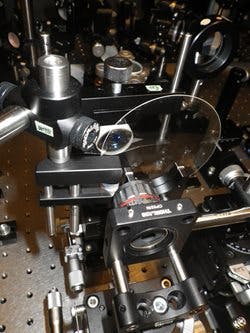University of Tokyo (Tokyo, Japan) researchers have developed a new high-speed camera that can record events at a rate of more than 1-trillion-frames-per-second. That speed is more than one thousand times faster than conventional high-speed cameras. Called STAMP, for Sequentially Timed All-optical Mapping Photography, the new camera technology "holds great promise for studying a diverse range of previously unexplored complex ultrafast phenomena," said Keiichi Nakagawa, a research fellow at the University of Tokyo, who worked to develop the camera with colleagues from an array of Japanese research institutions.
RELATED ARTICLE: Trillion fps visualizations image light in slow motion
Conventional high-speed cameras are limited by the processing speed of their mechanical and electrical components. STAMP overcomes these limitations by using only fast, optical components. Another optical imaging technique, called the pump-probe method, can create movies with an even higher frame rate than STAMP, but can only capture one frame at a time—limiting its use to processes that are exactly reproducible.
STAMP relies on a property of light called dispersion that can be observed in the way a misty sky splits sunshine into a rainbow of colors. Similarly, STAMP splits an ultrashort pulse of light into a barrage of different colored flashes that hit the imaged object in rapid-fire succession. Each separate color flash can then be analyzed to string together a moving picture of what the object looked like over the time it took the dispersed light pulse to travel through the device.
In the first iteration of STAMP, the number of frames that the camera could take in a single shot (each frame separated by one one-trillionth of a second) was limited to six. Currently, the team is constructing an improved STAMP system that can acquire 25 sequential images, enough to observe many ultrafast phenomena. Nakagawa believes the number of frames could eventually be increased to 100 with current technology.
Nakagawa notes that because STAMP operates on the assumption that all the differently colored daughter pulses interact with the imaged object in the same way, the camera should not be used to image samples whose optical properties change over the range of wavelengths STAMP uses.
Even given STAMP's limitations, the technology has enormous potential, Nakagawa says. His team has already used it with image electronic motion and lattice vibrations in a crystal of lithium niobate and to observe how a laser focused onto a glass plate creates a hot, rapidly expanding plume of plasma. Additional possible phenomena include the laser ignition of fusion, the phase transition of materials, and the dynamics of a Coulomb explosion, an event in which intense electromagnetic fields (for example from a narrow laser beam) can force a small amount of solid material to explode into a hot plasma of ionized atomic particles.
"I think it is important to note that there might be many potential applications of STAMP that I have not imagined," Nakagawa said. "I hope more researchers will become interested in STAMP."
The CLEO presentation, "Motion Picture Femtophotography with Sequentially Timed All-optical Mapping Photography," by Keiichi Nakagawa, Atsushi Iwasaki, Yu Oishi, Ryoichi Horisaki, Akira Tsukamoto, Aoi Nakamura, Kenichi Hirosawa, Hongen Liao, Takashi Ushida, Keisuke Goda, Fumihiko Kannari, and Ichiro Sakuma, will take place from 16:00 to 18:00 on Tuesday, 12 May 2015, in Salon IV, San Jose Marriott, adjacent to the San Jose Convention Center, San Jose, CA.
SOURCE: OSA; http://www.osa.org/en-us/about_osa/newsroom/news_releases/2015/the_trillion-frame-per-second_camera/

